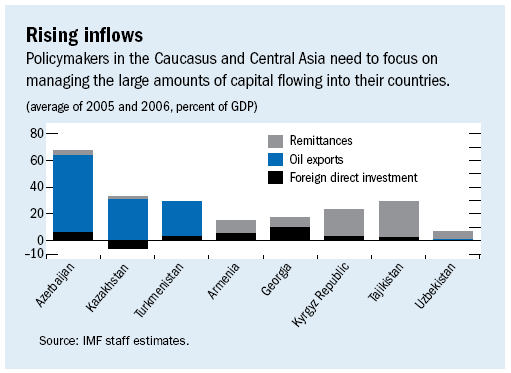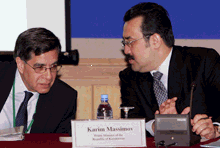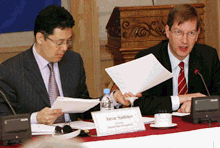
Typical street scene in Santa Ana, El Salvador. (Photo: iStock)
IMF Survey: Capital Inflows: A Mixed Blessing?
May 28, 2007
- Countries receiving inflows need to control inflation, manage exchange rate
- Inflows driven partly by high energy prices, favorable global financial markets
- Economic growth in region is fast—averaging more than 10 percent
Like many emerging market and developing countries around the world, nine countries in the Caucasus and Central Asia are on the receiving end of large inflows of foreign exchange.

Oil installation at Baku, Azerbaijan—one of nine Central Asian countries with large foreign exchange inflows (photo: David Mdzinarishvili/Reuters)
Caucasus and Central Asia
These countries are also grappling with some of the same issues of how to control inflation and manage the exchange rate. An April 25 seminar in Almaty, Kazakhstan, organized by the IMF's Middle East and Central Asia Department and co-sponsored by the National Bank of Kazakhstan, focused on policy options that would maximize the benefits of the inflows to the countries while maintaining external competitiveness and keeping inflation under control.
The nine countries—Armenia, Azerbaijan, Georgia, Kazakhstan, Kyrgyz Republic, Pakistan, Tajikistan, Turkmenistan, and Uzbekistan—are benefiting from large inflows of foreign exchange into their economies (see chart) in the form of buoyant export receipts, remittances, foreign direct investment, and external borrowing by banks.
The inflows are driven in part by high energy prices and a favorable situation in global financial markets. They have contributed to exceptionally fast economic growth in the region, averaging more than 10 percent a year for the past four years. They have also led to abundant liquidity, rising inflation, and pressures for exchange rate appreciation, which have complicated the conduct of monetary and exchange rate policies.

Potential for problems
Policymakers in these countries are thus grappling with two potentially serious challenges. First, they are struggling to prevent exchange rate appreciation from undermining their external competitiveness and efforts to diversify their exports while keeping inflation under control. Second, they are trying to ensure that the developing financial sectors in their economies are able to effectively intermediate the massive inflows while minimizing the risks of future financial sector problems.

Kazakh Prime Minister Karim Massimov (r) at seminar with IMF Middle East and Central Asia Department Director Mohsin Khan (photo: IMF staff)
The one-day seminar, attended by representatives of the central banks and governments of the nine countries, provided a forum in which the participants could discuss the strategies for managing strong foreign exchange inflows. It was opened by Kazakhstan's Prime Minister, Karim Massimov, and was co-chaired by Anvar Saidenov, Chairman of the National Bank of Kazakhstan, and Mohsin S. Khan, Director of the IMF's Middle East and Central Asia Department.
Growth strong across region
Following the opening remarks, David Owen (IMF) described how policymakers in the region have responded to these inflows and the resulting macroeconomic consequences. He noted that all countries have used the inflows to significantly strengthen their official reserves and that most countries—except Armenia and, to a lesser extent, Kazakhstan—had resisted changes in the nominal exchange rate.
As a result, broad money growth exceeded 30 percent in all countries in 2006. Also, all countries except Azerbaijan and Georgia have moderately tightened their fiscal stance in the face of these inflows.
The result has been an acceleration in inflation, which now averages more than 10 percent for the region and has contributed to a real exchange rate appreciation in virtually all the countries. Still, non-oil export growth was strong in all nine countries in 2006, exceeding 10 percent in many of them. Overall growth has thus continued to be strong across the region, except in the Kyrgyz Republic. Interestingly, the countries that saw the greatest real appreciation saw the strongest growth.

National Bank of Kazakhstan Chairman Anvar Saidenov (l) with Willy Kiekens, IMF Executive Director for Kazakhstan's country group (photo: IMF staff).
Lessons from outside
Following Owen's presentation, John Wakeman-Linn (IMF) reviewed how countries outside the Caucasus and Central Asian region have managed similar inflows. He drew six lessons for policymakers.
• First, because monetary policy cannot influence the real exchange rate beyond the short term, monetary authorities should focus primarily on maintaining inflation at moderate levels.
• Second, fiscal tightening—that is, spending cuts and higher taxes—is the only way to avoid real appreciation in the face of these inflows, but it may be politically difficult.
• Third, with real exchange rates likely to appreciate over the medium term, structural reforms designed to improve the business environment and encourage the use of inflows to finance investment rather than consumption will be essential to protect competitiveness.
• Fourth, capital controls designed to limit inflows are unlikely to be successful, at least beyond the short term.
• Fifth, central banks should seek to hold a substantial level of foreign reserves as a cushion against a possible future reversal of inflows while ensuring that any accumulation of reserves is consistent with their inflation objective.
• Sixth, to minimize the risks of a financial crisis in the event that the flows were to reverse, countries should strengthen prudential and other financial market regulations and, particularly if they face significant short-term inflows, seek to gradually make their exchange rates more flexible.
Case studies
Two case studies from the Caucasus and Central Asian region were then discussed in detail. Aasim Husain (IMF) reviewed Kazakhstan's experience in managing rapidly rising oil export receipts, foreign direct investment, and bank loans. He noted that Kazakhstan had seen roughly $140 billion in inflows in the three years from 2004 through 2006.
Although Kazakhstan saved a large share of these inflows in its oil fund, its central bank reserves increased sharply as well. A part of this increase was sterilized, and fiscal policy was tightened modestly, but money growth still increased to almost 80 percent in 2006.
Saidenov highlighted the challenges facing Kazakhstan's central bank in managing the inflows and underscored the measures it had taken to tighten the monetary stance. Inflation had picked up somewhat, Saidenov noted, but remained in check despite the surge in inflows.
"Because monetary policy cannot influence the real exchange rate beyond the short term, monetary authorities should focus primarily on maintaining inflation at moderate levels."
Nienke Oomes, the IMF's Resident Representative in Armenia, discussed Armenia's management of rapidly rising remittances, which have increased almost 500 percent in six years. Unlike other countries in the region, Armenia has tried to keep inflation under control despite the inflows and has kept average inflation over the past two years to less than 2 percent.
As a result, the nominal exchange rate has appreciated by about 30 percent over the past two years, despite a continued tight fiscal stance. Even so, the current account deficit has declined moderately in recent years, exports have remained roughly constant as a share of GDP, and GDP has grown at double-digit levels for the past five years.
Real appreciation
Tigran Sargsyan, Chairman of the National Bank of Armenia, agreed with this assessment of Armenia's performance. He noted that it remains an open question whether the real appreciation will adversely affect Armenian exports over the medium term.
Lively discussions followed each presentation, with participants focusing on how to apply the lessons to their particular country circumstances. Khan noted that the seminar had raised several important questions, at least two of which—the causes of the rapid growth in money demand throughout the region and the likely impact of medium-term real appreciation on exports in the region—will be investigated by IMF staff.







